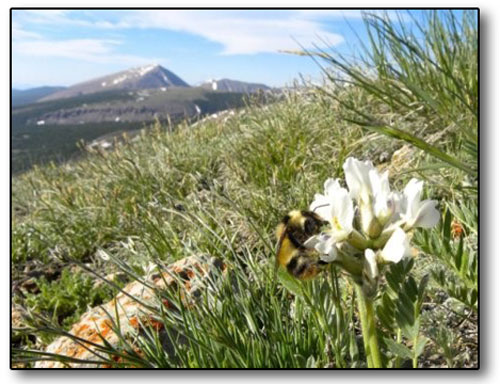
A bee pollinates a flower on Pennsylvania Mountain. Scientists have found that with climate change, the number of long-necked wildflowers – alpine bees’ min food source – has declined. However, over the last 40 years the bees have adapted with shorter tongues to access the more plentiful, short-necked flowers. /Photo by Candace Galen
Tip of their tongues
Bees develop surprising way to adapt to climate change
by Allen Best
Pennsylvania Mountain rises to 13,006 feet in the Mosquito Range of Colorado. From the summit, you can look down on the old mining towns of Leadville and Fairplay as well as a mining operation on a nearby mountain.
The above-treeline slopes of Pennsylvania Mountain, however, have remained pristine, distant from pesticides and other human influences.
Or so researchers studying wildflowers and bumble bees thought, until they noticed something that surprised them. The bumble bees above timberline were different than they were in the past. Historically, alpine bumble bees comprised 95 to 99 percent of bumble bees on the above-treeline slopes of Pennsylvania Mountain, as well as two other sites in Colorado’s Front Range. Now they share the habitat with lowland species, but even more surprisingly, there has been a curious change in their anatomy. The tongues of the alpine bees appear to be shorter than in the past.
These bumble bees were part of what scientists call an ecological partnership, or a mutualism. Long-tongued bees, with tongues up to half the length of their bodies, are better able to forage and pollinate the long-tubed wildflowers of Indian paintbrush, monkshood and other alpine species. Both partners benefited from this specialization: the flowers get pollinated and the bees get nectar.
To find out why tongues shrunk, biologists pursued several hypotheses through field research in the summers of 2008-14. They concluded that the high-altitude bees have been adjusting to warming temperatures. In their research, published in the Sept. 25 issue of the journal Science, they point to a decline in wildflowers as the base cause. With fewer of the already more-rare long-tubed flowers available, the bumble bees adapted to the broader menu of more abundant shorter-tubed wildflowers the last 40 years or so.
Koos Biesmeijer, an ecologist at the Naturalist Biodiversity Center in Leiden, the Netherlands, who was not involved in the study, described it as “very powerful.” That the changes occurred in just 40 years “is a really significant finding,” he told Science. He said this suggests that bee populations can adapt to effects created by warming temperatures.
Jennifer C. Geib, a biologist at Appalachian State University in Boone, N.C., and one of the study authors, told Mountain Town News that she had been traveling to Colorado to study the plants on Pennsylvania Mountain since she was a graduate student in 2003. Her study was about how the abundance of bumblebee pollinators benefitted the plants.
In 2012, she along with a former adviser Candace Galen, and Nicole Miller-Struttmann, of SUNY-Old Westbury, formed a collaboration to compare alpine plant-pollinator interactions in modern times to those of the past. That’s when the anomaly was discovered. The short-tongued bumble bees were much higher on the slopes than was expected.
Geib says the current study would have been impossible had it not been for researchers in the 1960s and 1970s who had taken measurements, providing baselines for comparison.
One important comparison is temperature change. The paper reports that minimum summer temperatures have increased about two degrees Celsius (3.6 degrees Fahrenheit) on Pennsylvania Mountain since 1960. The changes have not favored alpine flowers, which don’t grow as well when nighttime temperatures stay above 37.85 degrees Fahrenheit (3.25 degrees Celsius). From 1960-85, temperatures associated with reduced flowering occurred 12 percent of the years on Pennsylvania Mountain, but 48 percent of the years since 1985.
Warming summer temperatures over the last 56 years have also been recorded on two other mountains in Colorado’s Front Range, Niwot Ridge and Mount Evans, which were also used in the study from 2012-14.
This loss of wildflowers wasn’t universal on the mountain. Toward the summit, flowers still did well. By definition, however, there’s less land near mountain summits. On Pennsylvania Mountain, total food resources for alpine bumble bees have fallen 60 percent since the 1970s. As a result, bees adapted by developing tongues that are, on average, 25 percent shorter and thus access to a broader menu.
Geib routinely arrives in Colorado in mid-June and stays till min-August, hiking every morning above treeline to study bees and wildflowers until thunder clouds chase her back down in the afternoons.
The effect of this new tongue length cannot be registered quickly on the wildflowers because, unlike bees that reproduce annually, they have long lives, 50, even 100 years.
Does this mean that the wildflowers above treeline will forevermore be more scarce? Not necessarily, says Geib. Although climate change models predict increasing warmth, decreasing soil moisture and decreased snowpack, if this doesn’t hold true, then the plants should be able to recover, she said. “If that happens, then instead of this being a change, it would just be a hiccup,” she says.
